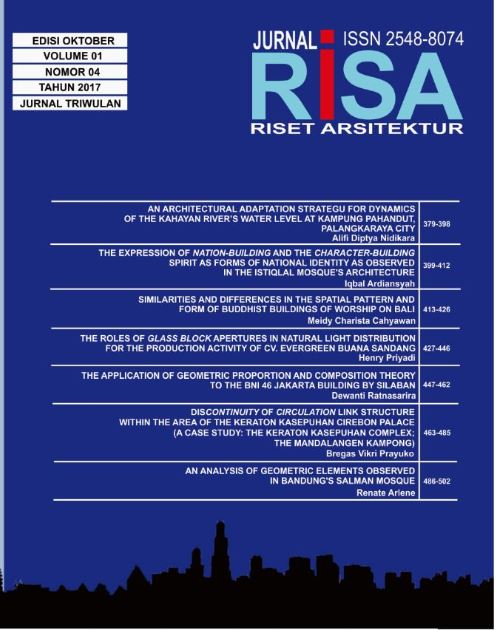DISCONTINUITY OF LINGKAGE CIRCULATION STRUCTURE WITHIN THE AREA OF THE KERATON KASEPUHAN CIREBON (A Case Study: The Keraton Kasepuhan Complex; The Mandalangen Kampong)
DOI:
https://doi.org/10.26593/risa.v1i04.2756.463-485Abstrak
Abstract- The Kasepuhan Cirebon Palace is a living and standing city monument that acts as a city artifact. The existence of the palace itself has been established since the fourteenth century as the kingdom’s capital. A castle cannot stand on its own as a city monument, hence the existence of urban function elements such as; Housing, Circulation, and Fixed Activities as described by Aldo Rossi in The Architecture of the city, 1982. Within the complex of this palace, there are two main areas surrounded by a fortress wall, namely the Keraton complex as the dwelling for Sultan Sepuh (the King), and the Kampung Mandalangen Complex as the dwelling for abdi dalem (servants, subordinates) and royal relatives. The method used in this research is descriptive-quantitative with Continuity, Connectivity, and Depth analysis (Marshall, Stephen, Streets & Patterns. 2003) to discover Street Types in the form of stem, spine and cross-connector within the area. After discovering the Backbone of the complex, (the writer) then descriptively provides the Ragaan (visual/description) in the form of the orientation of the complexes towards one another. In time, many changes have happened to this area. Special mention must be made of the phenomenon of open/close permeability to the Keraton Kasepuhan Cirebon (between complexes and outside of the complex), along with the phenomenon of spatial non-physical aspects (palatial policy and citizens’ behavior) that affects the spatial physical element. Both phenomena have created a shift in the Circulation link structure of both complexes, as well as relations between both complexes.
Keywords: Keraton Kasepuhan Cirebon, Relation, Circulation Link Structure, Backbone, DisContinuity.









